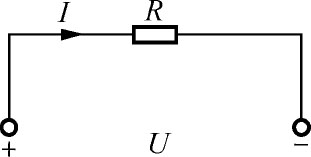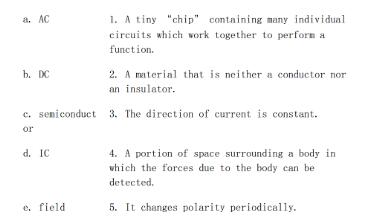




The flow of electrons through a conductor is called a current. Current flow is represented by the letter symbol I. The basic unit in which current is measured is the ampere (A). One ampere of current is defined as the movement of one coulomb (6.28×10 18 electrons) past any point of a conductor during one second of time.
When it is desirable to express a magnitude of current smaller than the ampere, the milliampere(mA) and the microampere (μA) units are used. One milliampere is equivalent to one-thousandth (0.001) of an ampere, and one microampere is equivalent to one-millionth (0.000001) of an ampere.
The term voltage (represented by the letter symbol U) is commonly used to indicate both a difference in potential and an electromotive force. The unit in which voltage is measured is the volt. One volt is defined as that magnitude of electromotive force required cause a current of one ampere to pass through a conductor having a resistance of one ohm.
A magnitude of voltage less than one volt is expressed in terms of millivolts (mV) or microvolts(μV). Larger magnitudes of voltage are expressed in kilovolts (kV). One kilovolt equals one thousand volts.
The opposition to current is called electrical resistance and is represented by the letter symbol R.The unit of resistance is the ohm, a term that is often expressed by using Ω. One ohm is defined as that amount of resistance that will limit the current in a conductor is one ampere when the voltage applied to the conductor is one volt. Larger amounts of resistance are commonly expressed in kiloohm (kΩ) and in megohm (MΩ).
The relationship between volts, amperes, and ohms can be represented by “Ohm’s Law”. “Ohm’s Law” states that the ratio of the voltage between the ends of a wire and the current flowing in it is equal to the resistance of the wire. Now we can say that when a given voltage is applied across the ends of the wire, an electric current always flows along it, and the value of this current depends on the resistance of wire (as shown in Fig.2-1).

Fig.2-1 Current, Voltageand Resistance
conductor [kən'dʌktə] n. 导体,导线
ampere ['æmpɛə] n. 安培
coulomb ['ku:lɔm] n. 库仑
magnitude ['mægnitju:d] n. 大小,数量,巨大,广大
equivalent [i'kwivələnt] adj. 相等的,相同的,等量的
volt [vəult] n. 伏特
electromotive force 电动势
electric current 电流
1. The flow of electrons through a conductor is called a current.
译文:通过导体的电子流称为电流。
2. The basic unit in which current is measured is the ampere (A).
译文:度量电流的基本单位是安培。
句中in which current is measured是定语从句,修饰unit。
3. to be defined as
“给……下定义为”,后可接名词或宾语从句,如课文中第一段。
4. When it is desirable to express a magnitude of current smaller than the ampere, the milliampere(mA) and the microampere (μA) units are used.
译文:当需要表示比安培小的电流量时,可用毫安(mA)和微安(μA)。
it是形式主语,不定式to express a magnitude of current smaller than the ampere充当真正的主语。
5. One volt is defined as that magnitude of electromotive force required cause a current of one ampere to pass through a conductor having a resistance of one ohm.
译文:使1安培电流流过电阻为1欧姆的导体所需的电动势定义为1伏特。
(1)过去分词required,充当后置定语,修饰electromotive force。(2)having a resistance of one ohm 是现在分词短语,充当后置定语,修饰conductor。
6. The unit of resistance is the ohm, a term that is often expressed by using Ω.
译文:电阻的单位是欧姆,常用Ω表示。
a term…为ohm的同位语,其中that is often expressed by using Ω是定语从句,修饰term。
7. One ohm is defined as that amount of resistance that will limit the current in a conductor is one ampere when the voltage applied to the conductor is one volt.
译文:1欧姆的定义是,当加到导体上的电压为1伏特时,将导体中的电流限制为1安培所需的电阻值。
that引导定语从句,修饰amount of resistance,其中when the voltage applied to the conductor is one volt是时间状语从句。
8. The relationship between volts, amperes, and ohms can be represented by “Ohm’s Law”.
译文:伏特、安培和欧姆之间的关系可用欧姆定律表示。
欧姆定律,即电阻等于电压除以电流, R = U / I ( U = IR 或 I = U / R )。
1. Write T (True) or F (False) beside the following statements about the text.
a. Current flow is represented by the letter symbol I.
b. One milliampere is equivalent to one-thousandth (0.001) of an ampere, and one microampere is equivalent to one-billionth (0.000000001) of an ampere.
c. The term voltage is commonly used to indicate a difference in potential but electromotive force is not.
d. One kilovolt equals one thousand volts.
e. The opposition to current is called electrical resistance.
f. Larger amounts of resistance are commonly expressed in kiloohm (kΩ) and in megohm (MΩ).
g. The flow of electrons through a conductor is called a resistance.
h. One volt is defined as that magnitude of electromotive force required cause a current of one ampere to pass through a conductor having a resistance of one ohm.
2. Match the following terms to appropriate definition or expression.

3. Fill in the missing words according to the text.
a. One ampere of current is defined as the movement of _____ coulomb (6.28×10 18 electrons) past any point of a conductor during _____ second of time.
b. One milliampere is equivalent to _____ (0.001) of an ampere, and one microampere is equivalent to _____ (0.000001) of an ampere.
c. One volt is defined as that magnitude of electromotive force required cause a current of one to pass through a conductor having a _____ of one ohm.
d. One ohm is defined as that amount of _____ that will limit the current in a conductor is one ampere when the _____ applied to the conductor is one volt.
4. Translate the following paragraphs into Chinese.
The unit for potential difference, or electromotive force, is the volt. The abbreviation, or symbol,for this unit is V. Voltage is expressed in volts. Recall that one volt equals the amount of electromotive force (emf) that moves a current of one ampere through a resistance of one ohm.
The unit of measure for current flow is the ampere. The abbreviation, or symbol, for this basic unit of measure is A. Remember that one ampere equals an electron flow of one coulomb per second past a given point.
Resistance is another electrical parameter that two letter: “R” represents the general term resistance and the Greek letter omega (Ω) represents the unit of resistance, the ohm. Remember that one ohm equals the resistance that limits the current to one ampere with one volt applied.
Another electrical parameter is conductance. Conductance is the opposite of resistance. The unit of conductance is the siemens (S) named after the scientist Ernst Siemens. The abbreviation for the general term conductance is G.
5. Translate the following sentences into English.
a. 电压的单位是伏特,用符号V表示。
b. 电流的单位是安培,用符号A表示。
c. 1伏特的电压施加在导体上产生了1安培的电流,此时电阻为1欧姆。
d. 欧姆定律表示了电流、电压、电阻之间的关系。